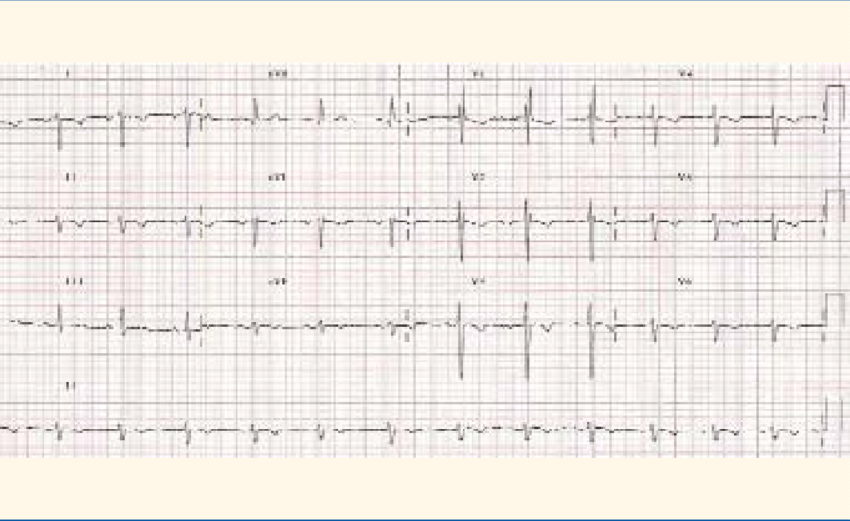The View page displays a submission's general information and data. Ver vídeo
Información del envío
Número del envío: 1462
ID del envío: 1471
Submission UUID: 1b05d796-173c-403e-ab7a-57d65e7e54e6
Submission URI: /es/form/wizard-fichatraductologica
Created: Sáb, 23/07/2022 - 20:42
Completed: Sáb, 23/07/2022 - 20:44
Changed: Sáb, 23/07/2022 - 20:44
Remote IP address: (desconocido)
Enviado por: HECTOR SEBASTIAN JANNE OROZCO LUYANDO
Idioma: Español
Is draft: No
Página actual: webform_confirmation
Form Ficha Terminológica: Ficha Traductológica
Término
ectopic atrial rhythm
Inglés (Estados Unidos) (214)
Ciencias Biológicas, Químicas y de la Salud (403)
Médico Cirujano (422)
Cardiología
A cardiac rhythm resulting from either an abnormal electrical focus in the atria or intra-atrial reentry.
Ectopic Atrial Rhythm. (22 de noviembre de 2007). Net Doc. Recuperado el 16 de junio de 2022 de https://netdoc.com/ectopic-atrial-rhythm/
This led to a persistent heart rate reduction to a physiologic level (80–100 beats/min at rest) with alternating periods of restored sinus rhythm and ectopic atrial rhythm. Subsequent ECG recordings showed sinus rhythms with regular AV conduction and no abnormalities of de- or repolarization (Figure 2). No adverse effects attributable to Ivabradine were registered. After stabilization Esmolol infusion was discontinued and the beta-blocker therapy was switched to Metoprolol administered orally (1 mg/kg/d). Holter evaluation before discharge (1 week after admission) showed sinus rhythm with short times of ectopic atrial rhythm and a regular diurnal pattern and heart rate.
Michel, H., Heißenhuber, F., Wellmann, S., Melter, M., & Gerling, S. (2020). Ectopic Atrial Tachycardia in a 12-Month-Old Girl Treated With Ivabradine and Beta-Blocker, a Case Report. En Frontiers in Pediatrics (Vol. 8). Frontiers Media SA. https://doi.or
Español
ritmo auricular ectópico
Nominal (221)
México (Mex.) (192)
Las contracciones cardíacas que se producen automáticamente debido a otras contracciones en el miocardio o en el sistema de conducción.
Ivanov, A. (2017). ¿Cuál es el ritmo auricular ectópico? Recuperado el 16 de junio de 2022 de http://www.es.nextews.com/a0c7120e/
Luego se analizó el tipo de arritmia que fue diagnosticada con mayor frecuencia. La arritmia sinusal respiratoria fue la que tuvo el mayor número de diagnósticos con un total de 157 pacientes, lo que corresponde al 44%. En segundo lugar fue diagnosticado el ritmo auricular ectópico con un total de 90 pacientes, es decir el 25% . En tercer lugar, taquicardia supraventricular con 59 diagnósticos correspondiente al 17% del total de la muestra. En menor porcentaje se presentaron trastornos de la conducción con un total de 46 diagnósticos, lo que corresponde al 13%. Finalmente fueron diagnosticados 3 casos de fibrilación auricular y 1 paciente con diagnóstico de síndrome de reentrada, correspondiente al 1 y 0.5 % respectivamente.
Nevarez Gilbert, A. B. (2014). Cardiopatía congénita como factor de riesgo de arritmias en niños hasta 18 años: estudio retrospectivo del área de consulta externa del Hospital de Niños de Guayaquil Dr. Roberto Gilbert Elizalde. Universidad Católica de San
Multimedia

Externa
https://www.researchgate.net/profile/David_Crespo-Marcos/publication/43693115/figure/download/fig2/AS:667796975390754@1536226614914/Figura-1-ECG-ritmo-auricular-ectopico-P-negativa-en-I-y-positiva-en-aVF-eje-del.png
https://www.youtube.com/watch?v=UlW346T4gSg
Externa
https://www.youtube.com/watch?v=UlW346T4gSg
